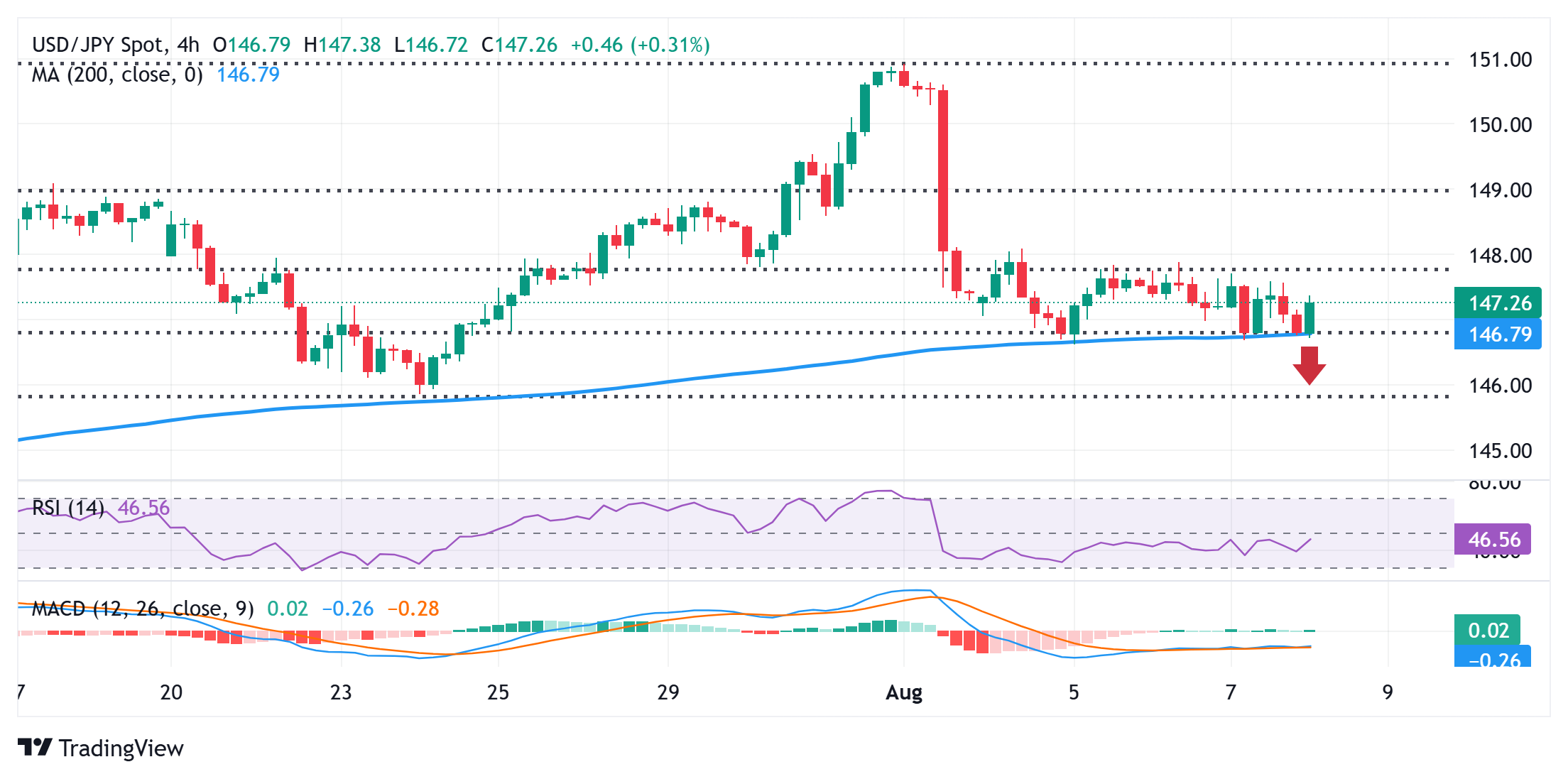Created
: 2025.08.08














![]() 2025.08.08 11:39
2025.08.08 11:39
The Japanese Yen (JPY) attracts some intraday sellers after the Summary of Opinions from the Bank of Japan's (BoJ) July meeting showed that policymakers remain worried about the potential negative impact of higher US tariffs on the domestic economy. This adds to the uncertainty over the likely timing of the next BoJ rate hike. Furthermore, a generally positive risk tone is seen undermining the safe-haven JPY, which, in turn, assists the USD/JPY pair to once again bounce off the 146.70 support zone during the Asian session on Friday.
Investors, however, seem convinced that the BoJ will raise interest rates by the year-end. In contrast, traders now see a greater chance that the US Federal Reserve (Fed) will lower borrowing costs at the September policy meeting. This, in turn, should keep a lid on any meaningful US Dollar (USD) recovery from a two-week low touched on Thursday and help limit deeper losses for the lower-yielding JPY. Hence, it will be prudent to wait for strong follow-through buying before confirming that the USD/JPY pair has bottomed out in the near term.

From a technical perspective, spot prices remain confined in the weekly trading band. Against the backdrop of last week's sharp pullback from the 151.00 neighborhood, or the highest level since March 28, the range-bound price action might still be categorized as a bearish consolidation phase. Moreover, slightly negative oscillators on the daily chart suggest that the path of least resistance for the USD/JPY pair is to the downside.
Hence, any further move up might continue to attract fresh sellers and remain capped near the 147.75-147.80 region, representing the 38.2% Fibonacci retracement level of the upswing in July. That said, some follow-through buying, leading to a subsequent strength beyond the 148.00 mark, could lift the USD/JPY pair to the 148.45-148.50 region. The momentum could extend further towards the 23.6% Fibo. retracement level, just ahead of the 149.00 mark.
On the flip side, the 146.75-146.70 confluence - comprising the 200-period Simple Moving Average (SMA) on the 4-hour and the 50% Fibo. retracement level - might continue to protect the immediate downside. A convincing break below should pave the way for deeper losses and drag the USD/JPY pair to sub-146.00 levels, or the 61.8% Fibo. retracement level. Some follow-through selling below the latter could expose the 145.00 psychological mark.
The Bank of Japan (BoJ) is the Japanese central bank, which sets monetary policy in the country. Its mandate is to issue banknotes and carry out currency and monetary control to ensure price stability, which means an inflation target of around 2%.
The Bank of Japan embarked in an ultra-loose monetary policy in 2013 in order to stimulate the economy and fuel inflation amid a low-inflationary environment. The bank's policy is based on Quantitative and Qualitative Easing (QQE), or printing notes to buy assets such as government or corporate bonds to provide liquidity. In 2016, the bank doubled down on its strategy and further loosened policy by first introducing negative interest rates and then directly controlling the yield of its 10-year government bonds. In March 2024, the BoJ lifted interest rates, effectively retreating from the ultra-loose monetary policy stance.
The Bank's massive stimulus caused the Yen to depreciate against its main currency peers. This process exacerbated in 2022 and 2023 due to an increasing policy divergence between the Bank of Japan and other main central banks, which opted to increase interest rates sharply to fight decades-high levels of inflation. The BoJ's policy led to a widening differential with other currencies, dragging down the value of the Yen. This trend partly reversed in 2024, when the BoJ decided to abandon its ultra-loose policy stance.
A weaker Yen and the spike in global energy prices led to an increase in Japanese inflation, which exceeded the BoJ's 2% target. The prospect of rising salaries in the country - a key element fuelling inflation - also contributed to the move.
![]()
Created
: 2025.08.08
![]()
Last updated
: 2025.08.08

FXStreet is a forex information website, delivering market analysis and news articles 24/7.
It features a number of articles contributed by well-known analysts, in addition to the ones by its editorial team.
Founded in 2000 by Francesc Riverola, a Spanish economist, it has grown to become a world-renowned information website.
We hope you find this article useful. Any comments or suggestions will be greatly appreciated.
We are also looking for writers with extensive experience in forex and crypto to join us.
please contact us at [email protected].
Disclaimer:
All information and content provided on this website is provided for informational purposes only and is not intended to solicit any investment. Although all efforts are made in order to ensure that the information is correct, no guarantee is provided for the accuracy of any content on this website. Any decision made shall be the responsibility of the investor and Myforex does not take any responsibility whatsoever regarding the use of any information provided herein.
The content provided on this website belongs to Myforex and, where stated, the relevant licensors. All rights are reserved by Myforex and the relevant licensors, and no content of this website, whether in full or in part, shall be copied or displayed elsewhere without the explicit written permission of the relevant copyright holder. If you wish to use any part of the content provided on this website, please ensure that you contact Myforex.
Myforex uses cookies to improve the convenience and functionality of this website. This website may include cookies not only by us but also by third parties (advertisers, log analysts, etc.) for the purpose of tracking the activities of users. Cookie policy